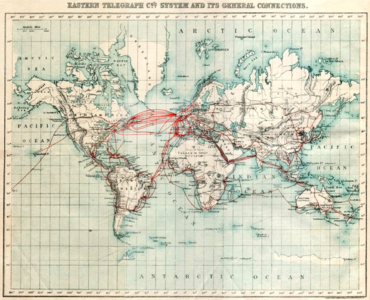
In the nineteenth century, the United Kingdom of Great Britain and Ireland had the world's first commercial telegraph company. British telegraphy dominated international telecommunications well into the twentieth. Telegraphy is the sending of textual messages by human operators using symbolic codes. Electrical telegraphy used conducting wires to send messages, often incorporating a telegram service to deliver the telegraphed communication from the telegraph office. This is distinct from optical telegraphy that preceded it and the radiotelegraphy that followed. Though Francis Ronalds first demonstrated a working telegraph over a substantial distance in 1816, he was unable to put it into practical use. Starting in 1836, William Fothergill Cooke, with the scientific assistance of Charles Wheatstone, developed the Cooke and Wheatstone telegraph. The needle telegraph instrument suggested by Wheatstone, the battery invented by John Frederic Daniell, and the relay invented by Edward Davy were important components of this system.
In 1846, Cooke and financier John Lewis Ricardo formed the Electric Telegraph Company which initially supplied telegraph systems to railway companies but soon branched out into other businesses, slowly building a network that could be used by the public. Many competing companies arose; the most important of them was the Magnetic Telegraph Company (the "Magnetic") formed in 1850. They used the telegraph invented by William Thomas Henley, which did not require batteries. The Electric and Magnetic companies soon formed a cartel to control the market. They were profitable, but most other companies were not.
Submarine telegraph cables were required to extend the telegraph beyond mainland Britain. Suitable insulation for these was unavailable until Scottish military surgeon William Montgomerie introduced gutta-percha in 1843. The Submarine Telegraph Company laid the world's first international submarine cable in 1851 connecting England with France. In 1864, John Pender formed the Telegraph Construction and Maintenance Company to manufacture and maintain the transatlantic telegraph cable for the Atlantic Telegraph Company. He formed many additional companies to lay various cables connecting Britain with its colonies in India, the Far East and Australia. Once these were laid, these disparate companies were merged into the Eastern Telegraph Company, established in 1872. In 1934, Cable & Wireless Ltd absorbed the company.
The inland telegraph companies were nationalised in 1870 and then operated as part of the General Post Office. Companies operating international submarine cables remained independent. A major mistake made during nationalisation was cost estimates failed to take into account the cost of purchasing railway company wayleaves, or even that it would be necessary to do so. The final bill far exceeded the original estimate. The telegraph was never profitable under nationalisation because of government policies. Prices were held low to make it affordable for as many people as possible, and the telegraph was extended to every post office issuing money orders, whether or not that office generated enough telegraph business to be profitable. Telegraph usage increased enormously under the Post Office, but it was never as cheap as the postal service, and growing competition from the telephone reduced its market share.
The telegraph was an important resource in both world wars, delaying its decline. The introduction of special greetings telegrams in 1935 proved highly popular and somewhat offset a further decline, but by 1970, telegram usage had fallen to its lowest total ever under nationalisation. Repeated price increases to control the deficit drove usage down even further. Post Office Telecommunications was separated from the Post Office as British Telecom in 1981. This was a first step towards its privatisation in 1984. In 1982 British Telecom ended its inland telegram service. International telegrams could be sent by telephone and were received by ordinary letter post. Some private wire use of telegraph continued after the end of the telegram service, and the telex system continued in use by an ever-diminishing group of private users. Most of these succumbed to alternatives on the internet in the 1990s.